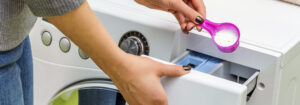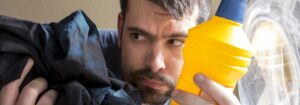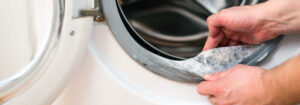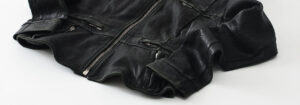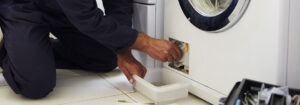If it is your first time using a new washing machine, or one that hasn’t been used for a long time, then it is best to treat the machine with caution. Even if the washing machine has been fine in the past, after a long time in storage, it may develop new faults. It is best not to assume that you can set it going before you head off for work. Leaving it unattended for its first use may mean you come back to a flooded floor from a leaking machine.
If a washing machine hasn’t been used in a while, then it may start to seize up, corrode, rot or dry out. Furthermore, if the machine hasn’t been left in the kindest environment, then the seals may go hard and crack or split, or in moist conditions, may rot away. Hoses may also suffer the same fate so leaks and flood can be common.
Using a washing machine for the first time
1. Examine the seals
Before using the washing machine, check the seals and hoses for any cracks, splits or holes. It is important to check the sump hose very carefully. Make sure the door can close properly too and that it feels as if there is a tight seal.
2. Spin cycle first
Before letting water enter the machine, it is wise to put the washing machine on a spin cycle first. This way you check that water can be removed from the machine. When putting the machine on spin cycle, you can check for any irregular noises by making sure the water pump in running and sounding normal.
If you cannot hear a pump (it sounds much the same as a dishwasher when the water is being taken away), then it may have seized. In this case, it may need replacing. On the other hand, if the pump is very loud, then there may be a block in the pump. In which case you’ll need to check for a blockage.
If it sounds fine, put the machine on for a full spin cycle to give it a chance to warm up before allowing water inside.
3. Watch for water
If you think the machine is safe, then put the machine on an empty wash cycle so that the machine fills up with water. Be prepared for water to leak on the floor and check that the machine doesn’t overfill with water, if the water goes higher than halfway up the glass then it is overfilling. If the machine does leak, try to work out where the leak is coming from, if not ask Just Fixed to try and troubleshoot the issue.
If the water is not overfilling and not leaking, then it is time to check if the water will drain away. Switch from the wash cycle to a spin cycle to see if the machine is able to pump away the water and there is no block in the pump.
4. Test it again
If it drains successfully, then put the machine on for a full cycle to give the machine a proper test. If there is no leak or any issue in the first ten minutes, then it is likely that the machine is good to use, but it is best to test it fully beforehand.
If you do find an issue, then speak to the experienced repair engineers at Just Fixed who can help to diagnose any issues and get your washing machine back up and running again.

